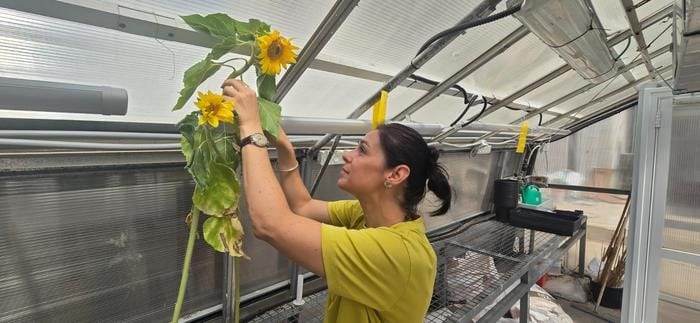
Sunflowers in a field can co-ordinate the circular motions of their growing stems to minimize the amount of shade each plant experiences – a study done in the US and Israel has revealed. By doing a combination of experiments and simulations, a team led by Yasmine Meroz at Tel Aviv University discovered that seemingly random movements within groups of plants can lead to self-organizing patterns that optimize growing conditions.
Unlike animals, plant motion is usually related to growth – which is an irreversible process that defines a plant’s morphology. One movement frequently observed in plants is called circumnutation, which describes repeating, circular motions at the tips of growing plant stems.
“Charles Darwin and his son, Francis, already identified circumnutations in their book, The Power of Movement in Plants, in 1880,” Meroz explains. “While they documented these movements in a number of species, it was not clear whether these have a function. It is only in recent years that some research has started to identify possible roles of circumnutations, such as the ability of roots to circumvent obstacles.”
Understanding self-organization
Circumnutation was not the initial focus of the team’s study. Instead, they sought a deeper understanding of self-organization. This is a process whereby a system that start outs in a disorderly state can gain order through local interactions between its individual components.
In nature, self-organization has been widely studied in groups of animals, including fish, birds, and insects. The coordinated movements of many individuals help animals source food, evade predators, and conserve energy.
But in 2017 a fascinating example of self-organization in plants was discovered by a team of researchers in Argentina. While observing a field of sunflowers growing in dense rows, the team found that the plants’ stems self-organized into zigzag patterns as they grew. This arrangement minimized the shade the sunflowers cast on one another, ensuring each plant received the maximum possible amount of sunlight.
Meroz’s team has now studied this phenomenon in a controlled laboratory environment. “Unlike previous work, we tracked the movement of sunflower crowns during the whole experiment,” Meroz describes. “This is when we found that sunflowers move a lot via circumnutations, and we asked ourselves whether these movements might play a role in the self-organization process.”
To inform the analysis, Meroz’s team considered two key ingredients of self-organization. The first involved local interactions between individual plants – in this case, their ability to adapt their growth to avoid shading each other.
The second ingredient were the random, noisy motions that allow self-organized systems to explore a variety of possible states. This randomness enables plants to adapt to short-term environmental changes while maintaining stability in their growth patterns.
Tweaking noise
For their sunflowers, the researchers predicted that these random motions could be provided by the circumnutations first described by Charles and Francis Darwin. To investigate this idea, they ran simulations of groups of sunflowers based closely on the movements they had observed in the lab. In these simulations, they tweaked the amount of noise generated by circumnutation with a level of control that is not yet possible in real-world experiments.
“By comparing what we saw in the group experiments with our simulation data, we figured out the best balance of these factors,” explains Meroz’s colleague, Orit Peleg at the University of Colorado Boulder. “We also confirmed that real plants balance these factors in a way that leads to near-optimal minimization of shading.”
As expected, the results confirmed that the random movements of individual sunflowers play a vital role in minimizing the amount of shading experienced by each plant.
Peleg believes that their discovery has fascinating implications for our understanding of how plants behave. “It’s a bit surprising because we don’t usually think of random movement as having a purpose,” she says. “Yet, it’s vital for minimizing shading. This finding prompts us to view plants as active matter, with unique constraints imposed by their anchoring and growth-movement coupling.”
The research is described in Physical Review X.
The post Sunflowers ‘dance’ together to share sunlight appeared first on Physics World.

